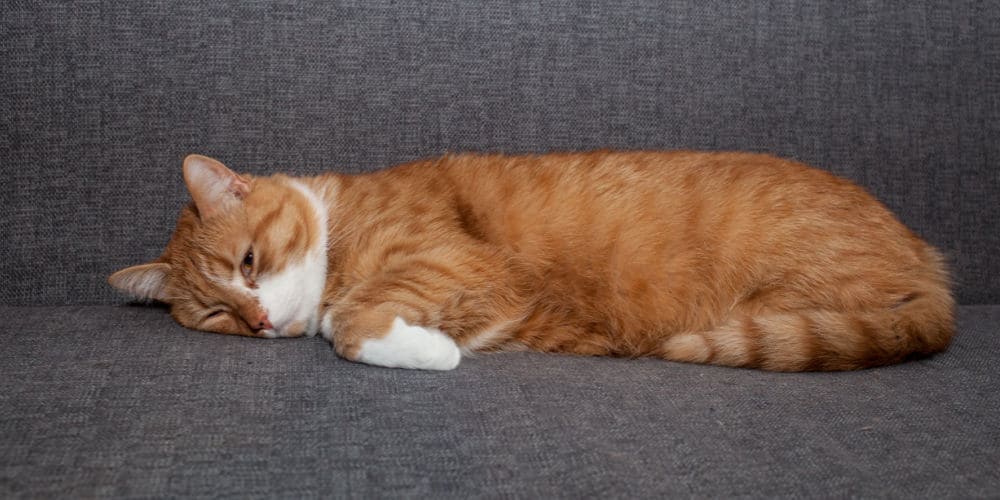Cat Drooling and Lethargic: What to Do?

Cats are moody animals that alternate between extreme playfulness and utter laziness. That’s why lethargy might be a little difficult to notice at first. However, if it persists for more than a day, most pet owners feel that something is off.
Drooling, on the other hand, isn’t too common in cats. Especially if it becomes excessive and continuous. The medical term for that is ptyalism or hypersalivation. Understandably, it’s an instant red flag that gets many cat parents to call the vet.
If you happen to see a cat drooling and lethargic, then it would be best to observe it closely. Sometimes the issue resolves in a day or two, but at other times it becomes essential to seek medical care.
In the coming sections, we’ll get into more detail about the possible causes of cat drooling and lethargy, when to see a vet and the best methods of prevention.
Cat Attitudes is reader-supported. When you buy through links on our site, we may earn an affiliate commission.
When Is a Cat’s Drooling and Lethargy Normal?
Cats are a bit different from dogs when it comes to drooling and activity levels. They drool much less and sleep much more.
Felines might drool when they’re either too happy or stressed out. Their reaction would probably also be accompanied by the cute kneading action many of them resort to as an expression of surplus emotion.
This often doesn’t last too long, as cats are capable of working through their emotions pretty quickly. Thus, the kitty should be back to its normal neat self within the day.
Lethargy, on the other hand, is one of the rights of being a cat. Some of them seem to get up for a few hours only per day, and soon go back to lazing around in their favorite spot. The cat’s parents usually know that this behavior is typical.
It starts feeling odd around mealtimes when the cat stops running towards its dry food bowl. Also, when the doorbell rings, or someone opens the window, but the cat neglects all that. This type of lethargy is the one that’s not normal.
Possible Causes of Cat Drooling and Lethargy
Lethargy is when a cat doesn’t respond to any kind of stimulation. This includes the movements around it, smells, sounds, and even direct touching. All these stimuli normally get a reaction from cats, but when something is off, they usually stop engaging.
If a cat starts hypersalivation together with clear signs of lethargy, then the cat’s parent should pay attention to any other associated symptoms. Also, if anything out of the norm might’ve happened in the previous week. That’s because drooling and lethargy are non-specific presentations that could be associated with several types of health issues.
Here are some of them:
- Dental and gum diseases
- Inflammation, injuries, or ulcers in the tongue
- Oral lesions
- Blockage in the esophagus
- Exposure to chemicals
- Insect bites
- Trauma caused by an accident or cat fight
- Neurological disorders causing difficulties in swallowing
- Motion sickness or nausea
- Metabolic disorders, especially kidney and liver problems
- Rabies resulting from a bite or scratch from an infected animal
Testing to Find the Real Cause
It’s clear from the previous list that there are many possible reasons for the cat’s condition. It’s also worth noting that cats are quite discrete with their pain. They don’t express their discomfort in simple, easy-to-understand terms. That’s why we have to resort to careful observation, examination, and medical testing.
Routine Questions the Vet Would Ask
Before meeting with the vet, try to write down as much information as you can about your cat. Any little piece of information might help. Here are some questions that the vet might ask:
- When exactly did you start noticing that the cat wasn’t behaving normally?
- What did the cat eat in the past few days?
- Does it suddenly prefer wet food to dry food?
- Do you have an indoor or outdoor garden?
- Does the cat urinate and defecate normally?
- Does the cat’s breath have an odd or unpleasant smell?
- Have you cleaned the house with new detergents recently?
- Did the cat show any changes in behavior in the previous weeks?
- Does the cat vomit?
- Does it have trouble breathing?
The doctor would then examine the cat, bearing in mind all the information you’ve just filled in. Some checks would require the cat to be sedated to avoid disturbing her too much. And also to prevent her from biting the vet.
Some illnesses, like rabies, need to be assessed right away. That’s because of the seriousness of this disease, the need for putting the cat in quarantine, and also as immediate action is imperative for recovery.
The exam could be conclusive, especially, if there’s a clear dental problem, oral injury, or esophageal blockage. Other issues would most probably need further investigation and testing.
Necessary and Additional Medical Tests
There are some basic tests that the vet needs to run. And these often rule out some of the big issues, in addition to pointing towards the possible root cause of the cat’s illness.
Blood work is among the basic requirements, as it would show signs of anemia, infection, inflammation, or metabolic abnormalities.
Urine analysis is also a necessary initial test, as it would reveal whether or not the cat’s kidneys are working properly, and also if there’s any infection.
A fecal analysis is sometimes requested if the cat isn’t eating, or if its excrement isn’t of the regular consistency
Dental X-rays are essential too, as oral problems are frequently behind the cat’s drooling.
Neck, chest, and abdominal X-rays to show if the cat has swallowed a foreign body and also to make sure that its organs are healthy and free from abnormal masses.
These tests should narrow down the possible causes. And there’s a good chance that the vet would pinpoint the reason for the cat’s drooling at this stage. However, there are some cases where further investigation is necessary.
Typically, the vet would request a CT scan and biopsy if a suspicious mass is discovered in any of the cat’s organs. This is infrequent though, and most often the basic tests are sufficient.
The next step is finding a suitable remedy for the cat and nursing it back to wellness.
Finding the Right Treatment for a Drooling Cat
The treatment of the cat’s drooling and lethargy depends entirely on what the problem is. Based on the presented case history, medical examination, and performed tests, the vet is usually able to describe a specific illness and prescribe a suitable treatment plan.
The treatment could be only medicine or some form of surgical intervention might be needed. The following are common remedies for a cat’s consistent drooling and loss of vitality.
Treating Dental and Oral problems
A specialist in cat dental care is usually needed for these procedures. Tooth extractions, gum treatments, and other interventions are often performed under general anesthesia. The cat would further take antibiotics after that, and the doctor would check her progress in a follow-up visit.
Dealing With an Ingested Foreign Body
The vet might be able to extract a small toy that’s stuck in the cat’s throat in the clinic. But an object that’s further down would need a more sophisticated procedure.
A surgical cut is rarely needed, and endoscopic interventions are often sufficient. The cat undergoes general anesthesia but is mostly able to return home on the same day.
The Remedy for Exposure to Toxins
Prompt action, in that case, is important. The vet would empty the cat’s stomach, and administer some medicines to neutralize the toxins, in addition to activated charcoal to decrease its potency.
The cat would still look tired and it might not be able to eat much for a few days. Full recovery could take up to 4 weeks.
Treating Nausea and Metabolic Disorders
This is among the more complex disorders, as the exact reason could be a bit tricky. Extensive testing is required and based on that the prescription might be a simple change in diet. If more serious problems are discovered, then surgical intervention could be needed.
Healing the Cat’s Trauma
Trauma is the body’s natural response after accidents, burns, or even feline fights. Often the cat suffers major cuts, lacerations, or fractured bones. The poor cat stays disoriented for a while and usually drools. Especially if its jaw is among the injured parts.
The immediate action is to tend to all the wounds, burns, or affected bones. The cat would need to be hydrated either orally or through an IV line. In some cases giving the cat a sedative would be necessary, while in moderate cases, painkillers would be sufficient.
The cat might need to spend a few days at the clinic, and then continue its recovery back home. Antibiotics and antiseptics should be administered for about one to two weeks till full recovery.
Prevention
An ounce of prevention is worth a pound of cure, and that’s why it’s important to take every necessary step toward keeping your cat healthy. Here are a few of these.
- Routine visits to the veterinarian clinic every year are a must-do. And the duration could go down to six months for very young kittens or aging cats.
- Dental checks are especially important.
- Some tests are capable of catching a disease at its outset. These are necessary and shouldn’t be foregone, since early diagnosis increases the probability of full recovery significantly.
- Cats are quite sensitive to some plants, detergents, insecticides, and other chemical substances. Thus, they shouldn’t be placed or used around pets.
- Cats are curious by nature, and they might swallow small objects but fail to ingest them fully. It’s best then to make sure that such objects aren’t anywhere near the cats.
- Rabies is a disease that can be transmitted by rodents, bats, dogs, and several other animals. Cats are only immune to it if they get the vaccine, and if they’re even scratched by another animal, it’s imperative to make sure they get the shots in a timely manner.
- Some cat species are more prone to metabolic diseases and cancers than others. However, a proper diet and routine exams could minimize that possibility.
Final Thoughts
A cat that’s lethargic, under the weather, and drooling might just be stressed out or overwhelmed. This usually doesn’t last for more than a day.
If the odd condition persists, then a visit to the vet would be wise. There are several reasons that could be behind the cat’s ailment, and only a specialist could identify the exact reason.
Treatment for most of the causes underlying a cat’s drooling and lethargic state is usually possible. Accurate observation of the cat’s behavior before thevet visit pays off, and so does prompt action.
As always, prevention is the best course of action, and it’s usually as simple as a yearly visit to the vet.
